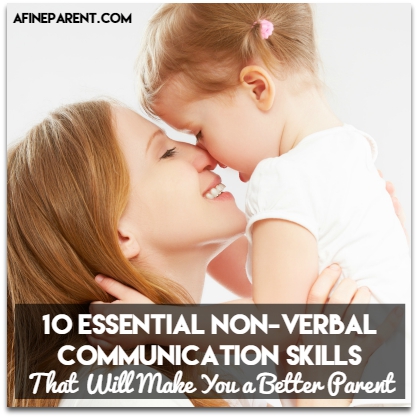 Ever wonder when your little ones will finally follow directions?
Ever wonder when your little ones will finally follow directions?
Do you want to encourage your children to respond positively to what you say?
And how can you make them better listeners?
Even more so, how can you positively affect their communication skills?
As parents, we spend much time speaking and instructing our kids. Yet, how many of us have thought about the nonverbal ways we communicate with our children?
Eye rolls, smiles, arms crossed, shoulders hunched.
Nonverbal communication can have long-lasting effects on how they listen, behave, process information, and speak to others. It also impacts their attitudes towards us parents and it affects how others see them.
Dr. Albert Mehrabian, author of Silent Messages, performed several studies on nonverbal language. He found that body language is a major aspect of communication. Who knew our physical mannerisms could speak such loud volumes?
Nonverbal communication may have serious effects on how well-liked a child becomes, and the types of opportunities offered to them in the future.
Bottom line: it can make them or break them.
As a mother of two and a speech-language pathologist, I’ve had to address this issue in a variety of ways. My little boy, a toddler, responds much better to my ‘messages’ when I take a moment to alter my gestures in a way that he will be receptive and willing to hear me out.
As almost every parent understands, kids won’t always pause what they’re doing to listen to mommy and daddy. It’s in their nature to play and pursue what they like. It’s often a struggle for us to get our little ones to pay attention to what we have to say.
But it’s imperative to remember that it’s not always what we say that will resonate with them, but how we convey our messages. We must also take a step back and carefully model the behaviors we would like to see in our children. Therefore, we need to work to better our nonverbal communication, so that they can effectively learn from us.
 A few weeks ago I began potty training my son, but to no avail. No matter how many times I told him to go sit on the potty, offered him treats and stickers, and sat and entertained him in the bathroom, nothing worked.
A few weeks ago I began potty training my son, but to no avail. No matter how many times I told him to go sit on the potty, offered him treats and stickers, and sat and entertained him in the bathroom, nothing worked.
Tired of cleaning up the accidents in my living room, I decided to alter the way I was trying to convince him to cooperate. I changed my manner of nonverbal communication and tried to connect with him literally on his level.
I bent down and reached eye level with my son, got closer, and softened the tone of my voice. I gently asked him to look at me and smiled.
I made a positive connection with him. Then I made my request. Hearing the encouraging tone of my voice, my son agreed. He followed me to the bathroom and tried to go again.
At that moment we both had a breakthrough – we connected.
It’s simple little breakthroughs like these that give way to bigger, far-reaching ones. Eventually, my son began enjoying using the potty and I put my clinical knowledge into practice.
I now try to intentionally use this nonverbal pattern to effectively communicate with my son. And I think I am a better parent for it.
I’ve imparted this lesson to my clients’ parents as well. In one instance, I reached out to the parents of one of my high-functioning autistic clients. I carefully explained that they needed to change their nonverbal language and get physically closer to their child. I explained the importance of making eye contact and rewarding their son with stickers or praise when he glances at them. They transformed their nonverbal language and impacted their son’s communication drastically. He began to show joint attention and his social skills gradually improved.
Luckily, there are many ways we can affect our children’s comprehension and communication skills of our children. Let us take a look at some concrete steps we can take:
1. The importance of eye contact
 Parents often overlook the significance of making eye contact with their children. According to the National Institute of Mental Health, a child’s use of eye contact is an important indicator of normal development.
Parents often overlook the significance of making eye contact with their children. According to the National Institute of Mental Health, a child’s use of eye contact is an important indicator of normal development.
When a child can attend to their parents’ face, they receive more cues to understand the verbal message. A child is not just focusing on the face but may also be paying attention to your lip movements. This may make the messages we give more ‘readable’ and perceivable.
2. Speaking at the child’s “level”
By bending down and speaking at your child’s level, not only are you more approachable and less intimidating to your child, but you are making the message more audible and accessible. Educators are often encouraged to teach on the same vertical plane to promote and strengthen teacher-student communication.
3. Using an open communication posture
When we hold our arms to the side, as opposed to crossed or wrapped around our bodies, we show our children that we are receptive to what they have to say. This might help encourage them to want to listen to us and communicate.
4. Positive facial expressions
Smiles, slightly upturned lips, and eyes widened in excitement can also affect how our children respond to our message. Once again, by imbuing a positive expression, we encourage our children to have positive responses. The Raising Children Network urges that the emotional experiences children have with others shapes their responses throughout life.
5. Joint attention
 Paying attention, in conjunction with your child, to the subject at hand (such as getting down on the floor with your child to wipe a mess together, as opposed to telling your child to clean up the mess) is critical to engaging your child on the topic at hand. When we look at and evaluate the topic of the conversation together with our children, we are involving them on a deeper level.
Paying attention, in conjunction with your child, to the subject at hand (such as getting down on the floor with your child to wipe a mess together, as opposed to telling your child to clean up the mess) is critical to engaging your child on the topic at hand. When we look at and evaluate the topic of the conversation together with our children, we are involving them on a deeper level.
Tomasello and Farrar conducted a study on child vocabulary development and joint attention. They found that children who were taught words while doing joint attention tasks acquired a greater vocabulary. If your child is not attending with you, get closer or even point to the topic. Hopefully they will do the pointing next time.
6. Our use of tone and prosodic patterns (paralanguage) when speaking to children
It’s no secret that babies and young children prefer motherese (high pitched child-directed speech) over any other form of being spoken to. Macquarie University in Sydney released research that motherese helps children identify where words begin and end. It can help them identify sounds, syllables, words, and finally sentences. Children are also more engaged in conversation with their parents when a high and varying rhythm of speech is used.
7. Gestures
Head nods, thumbs up, and hands up in excitement also positively impact interactions with children. We are nonverbally expressing acknowledgement and encouragement to our children.
8. Sounds (ah ha, uh uh)
Our use of vocal responses (non-words) may show our child that we are engaged in what they are saying. It can also encourage them because we are showing them that we are actively listening.
9. Proximity between parent and child
For young children, it’s important that the space between parent and child be relatively small (1-2 feet). As our children become adolescents it’s natural for the space to widen.
10. Locomotion (amount of movement a parent should/should not have)
In order to show our child that we are engaged in talking to them, our movements should be limited to gestures and expressions. Walking and pacing is not only distracting for your child but takes away from the closeness and connection you want to have with them to effectively communicate.
It is amazing how paying attention to our non-verbal communication and intentionally making a few minor tweaks can have such a huge impact on the way we connect with kids, and in turn how they interact with the world around them. Give it a shot – you might find yourself being pleasantly surprised.
The 2-Minute Action Plan for Fine Parents
Take a moment to inspect the last interaction with your child.
- Did your child mind what you were saying?
- In addition to your spoken words, what other non-verbal messages did you send your kids? Did it have an effect on how your child responded to you?
- On average, how much of your time do you spend each day displaying positive gestures, tone and facial expressions?
- How often do you get down to your child’s level and connect before you try to correct?
The Ongoing Action Plan for Fine Parents
The first step to improving your non-verbal communication skills is getting better at recognizing the non-verbal cues we are sending with the actual verbal messages we wish to convey. Spend the next week paying particular attention to this aspect of communication with your kids.
Next, pick one of the above tips to implement intentionally in your communication with your kids. For instance, you may choose to intentionally school your face to be softer and more open when you talk to your kids.
Yes, this may feel a little unnatural at first, but the response you get will eventually make it well worth the effort!
Hello Michele,
Interesting article. As I read your toilet-training incident and how you decided to handle it, I could not help but think of the many sessions, books and DVD’s that I have read and watched, mostly through my work, from Dr. Gordon Neufeld. What you described is a HUGE piece of his philosophy of “Collecting your Child”. We need to “Collect before we direct”. In other words, if we want our child to do something, we need to collect them first – by 1) getting their attention 2) get their eyes 3) smile & nod and then 4) direct. A perfect example that I have seen him demonstrate was with a 9 month old baby. As we meet a baby, WE want to hold/touch their hand but the baby does not and will not allow us to do that because they are unsure and will turn away and snuggle into mommy’s arms. So, if we do as above – get their attention, look at their eyes, smile/nod and wait for baby to smile back! We can NOW hold their hand! It doesn’t matter how old the other person is – it works! When he said that it works on everyone, I decided to try it on my then 13 year old “let’s sit at the computer and not pick up my dirty clothes everywhere after I have told you 100 times” daughter to prove him wrong. It worked. No yelling. Calm.
We need to “Collect before we Direct”.
I sooooo need to remember the “joint attention…” I too often tell my kids to clean up, then get frustrated that they’re not doing it. If I just get down on the floor and help them, I think we’ll all be the happier for it!
Too often we get so wrapped up in household tasks and other work that we forget why we’re doing those things in the first place – so we an spend time in a nice space with our kids. So let’s drop all the housework for a minute and just really spend that time with the kiddos.
YES! And lo the article doesn’t mention it, if you always have your nose in your work, your phone or your computer, while you are responding to your child, you imply that they are less important. If your child is acting out, try putting down your devices a bit more. As the saying goes: negative attention is better than no attention. Pro-actively prevent negative attention with positive attention.
Thanks Michele,
You’ve given us a lot of food for thought. I find that eye contact is particularly important when communicating effectively with my children. On your advice, I will try and soften my expressions – particularly when me eldest is being her most defiant!
Many thanks, Rachael
Great article! My wife, Kate, and I would agree with the 10 strategies – they are very sound. We co-authored a book on parenting, using temperament: “Great Parenting Skills (GPS) for Navigating Your Kid’s Personality” (available through AMAZON.COM) and we would suggest that when you combine an understanding of temperament with these 10 strategies, you will be able to maximize their effectiveness.
Thank you. excellent article. Enjoyed reading it and will put into practice. As parent we are aware of all above nonverbal communication skills but we also get caught up with other situations in our adult life that we sometimes slip (forget) putting above lists into practice and be the role model at all times as better parents, after all, we are all human beings and no one is perfect. It’s a continued improvement that we need to be reminded of as parents to be the best we can be for our children. Looking forward to receiving more helpful tips on parenting.
Insightful article. I would suggest that boys typically may be less comfortable with direct eye contact. Side-by-side communication especially when doing something together with your hands may make talking easier. Men feel more able to talk when they aren’t expected to have direct eye contact. One dad told me, “I tell my wife, if she wants me to listen to her I can’t look at her. If she wants me to look at her, I can’t necessarily hear what she is saying. I tell her to ‘choose one channel.'” Hope this helps lend another perspective!
Great article for “neuro-typical” kids. I’m not sure yet if the National Institute of Mental Health has officially commented on kids with developmental disabilities (ie specifically autism spectrum disorder) but, finally, parents , service care providers, educators and others are realizing the importance of honoring when ASD kids shy away from establishing and/or maintaining eye contact.
I’m curious to find out what Dr Mehrabian has to say about other non-verbal forms of communication; perhaps there are applications for parents with kids who have sensory challenges.
Very thoughtful article! Being mindful of nonverbal communication is also helpful with parenting tweens and teens. I have found that my two kids (ages 14 and 17) listen to me best when I make a point to use several of the nonverbal behaviors that Michelle points out in the article.
I love the thought that we parent best through connecting with our kids. I have found through experience that if I start to feel too emotional during a situation with my kids, it usually doesn’t end well; however, if I take a step back and attempt to connect with my child, the situation usually ends much better.
Thank yo for a thoughtful article.
Lovely to read Michelle’s article. As a mother of three boys aged 11, 8 and 2, I can guarantee that non-verbal communication does, literally, speak volumes, and not only with toddlers!